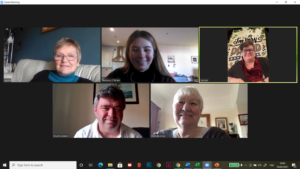Together we plan!
Inspiration, reflection and activities for a bright Big Local future
This handbook offers useful approaches to support your Big Local partnership in developing and planning its work during the COVID-19 crisis and future uncertainty.
It aims to support you and those working with you to reflect on what you have learned so far
in different ways:
- Focus outwards and look at what you have learned about your community and ways of
working during COVID-19. - Focus inwards and think about the needs of your partnership, building your strengths and skills in the way you work.
- Explore how you can use what you have learned to make plans for the future which meet new community needs.
Section 1
How are Big Local partnerships responding to COVID-19?
Our conversations with Big Local partnerships and review of national research suggest that it is useful to take two perspectives in relation to responses and how to plan for the future:
Changes to how we work, engage and respond to community need
These things are less tangible and more about the way we do things. Themes that seem
to be emerging from our engagement with Big Local areas and further research are:
Key roles played by Big Local areas during lockdown
We have brought together examples of how Big Local areas have responded and adapted
their plans in light of the pandemic as a resource for all areas – to share learning and
encourage new ways of thinking about common challenges.
We have discovered further evidence of the themes identified in Local Trust’s recent research
into The role of Big Local partnerships during lockdown. Partnerships have often played one or
more of these key roles:
Success has also relied on using the flexibility of the Big Local programme to adjust and vary
plans and budget allocation. Many partnerships reported plan reviews coming up or being
deferred. Partnerships highlighted a need for community consultation and engagement to better understand the changing needs in their community.
We have used the three categories above to group some responses from Big Local areas. They are a helpful way of seeing the different types of response, and, of course, there is lots of other activity happening that we didn’t hear about. If your Big Local area has an inspiring story to share, please update us on Workplace.
Case studies
Section 2
This section is intended to help your Big Local partnership look at what you have learned
about your community and your partnership throughout the pandemic – using the themes
identified in Section 1 – and to use what you know to shape plans.
How to use this handbook – three top tips:
In this action-focused section of the handbook you will see:
- A checklist of questions to investigate how your partnership is responding to the current situation
- A checklist of questions to find out what you know about your community in the light of COVID-19
- Activities to help you plan for the future
Further reading
- Digital Toolkit – Working online doesn’t need to be difficult: This interactive guide offers quick and easy steps you can take and tools you can use to get the most out of these online resources – all low-cost and high impact.
- Digital Pathway – COVID-19 has accelerated a trend towards digital that was already in motion. Our guide to help you stay connected in an increasingly digitised world.
Was this page helpful?
Thank you for your feedback!

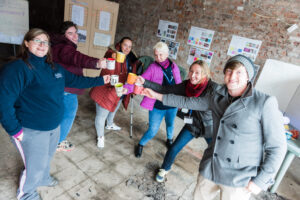
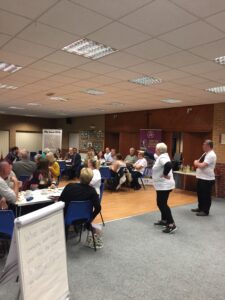
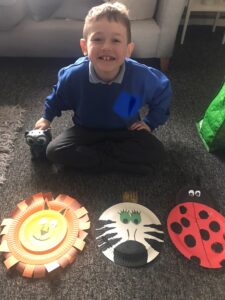
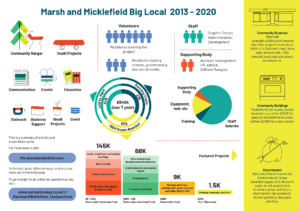 Back in March 2020, Marsh and Micklefield Big Local were about to launch their all-singing, all-dancing community consultation with a series of events to develop their new three-year plan and reinvigorate the partnership. They had identified a process for widening engagement, and worked out what everyone would contribute, all geared towards a new three-year plan to be submitted in October.
Back in March 2020, Marsh and Micklefield Big Local were about to launch their all-singing, all-dancing community consultation with a series of events to develop their new three-year plan and reinvigorate the partnership. They had identified a process for widening engagement, and worked out what everyone would contribute, all geared towards a new three-year plan to be submitted in October.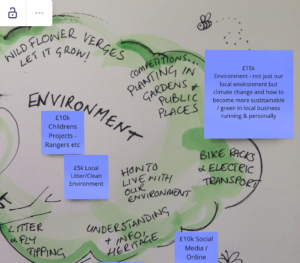 Local Trust’s offer to extend existing funding to allow longer for consultation and planning was welcomed. The in-depth thinking that Marsh and Micklefield had done about the messages they wanted to get out during their consultation was a good starting point but had to be used in different ways. However, the active team now consisted of three part-time staff, the chair and a social media volunteer, so the consultation had to be efficient as well as engaging.
Local Trust’s offer to extend existing funding to allow longer for consultation and planning was welcomed. The in-depth thinking that Marsh and Micklefield had done about the messages they wanted to get out during their consultation was a good starting point but had to be used in different ways. However, the active team now consisted of three part-time staff, the chair and a social media volunteer, so the consultation had to be efficient as well as engaging.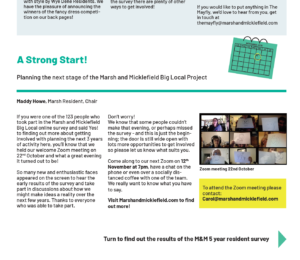 All those who had indicated on the survey that they would like to get involved in making final decisions about the plan were called or Zoomed and invited to a series of evening Zoom
All those who had indicated on the survey that they would like to get involved in making final decisions about the plan were called or Zoomed and invited to a series of evening Zoom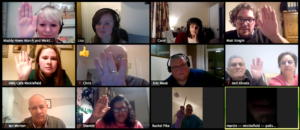 The 20 or so new community members who have participated in the Zoom consultations are all keen to be involved in decisionmaking and volunteering in the future. Some may form part of the new partnership, others may contribute one-off or specific volunteering. The three-year plan will reflect the changing priorities of the community on the back of the COVID-19
The 20 or so new community members who have participated in the Zoom consultations are all keen to be involved in decisionmaking and volunteering in the future. Some may form part of the new partnership, others may contribute one-off or specific volunteering. The three-year plan will reflect the changing priorities of the community on the back of the COVID-19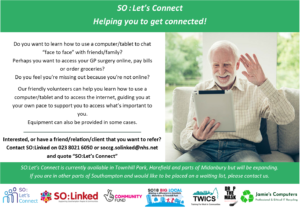 SO18 Big Local has experience of supporting people to get online and improve IT skills, having run Tea & Tech and, more recently, the Townhill Helping Hub, but these were on hold because of COVID-19. So, when SO:Linked (a local organisation linking people with local services and activities) approached them about getting involved in a digital inclusion project, the timing was perfect and the pilot for SO:Let’s Connect was born.
SO18 Big Local has experience of supporting people to get online and improve IT skills, having run Tea & Tech and, more recently, the Townhill Helping Hub, but these were on hold because of COVID-19. So, when SO:Linked (a local organisation linking people with local services and activities) approached them about getting involved in a digital inclusion project, the timing was perfect and the pilot for SO:Let’s Connect was born.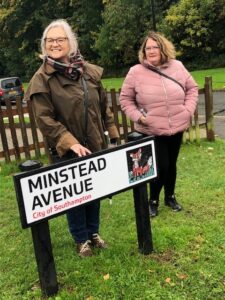 SO18 Big Local is taking advantage of the Measuring Change offer and working alongside WSA Community Consultants to look at how to measure the difference this project makes over
SO18 Big Local is taking advantage of the Measuring Change offer and working alongside WSA Community Consultants to look at how to measure the difference this project makes over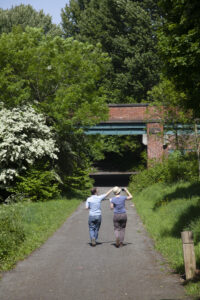
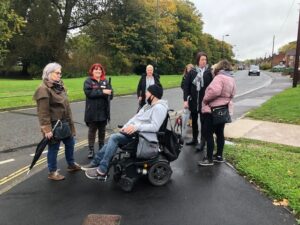
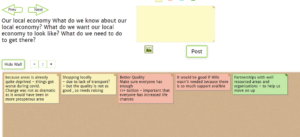
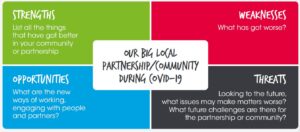 Encourage them to move around the room listing all the SWOTs they can think of. A similar approach can be taken online, asking people to
Encourage them to move around the room listing all the SWOTs they can think of. A similar approach can be taken online, asking people to a. Our community are kind and supportive to those who are vulnerable,
a. Our community are kind and supportive to those who are vulnerable,
